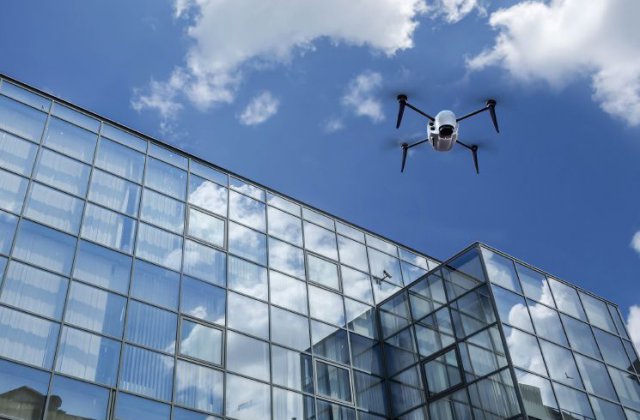The commercial property industry is expansive, totalling $750 billion across real estate, management and insurance. There’s also a certain amount of inherent risk for investors, particularly to property and infrastructure. Physical asset risk, which includes equipment or ageing roofs that need replacing, is one of the top-10 sources of risk in commercial real estate, according to CrowdStreet.
Accurate and timely drone-based assessments of property conditions can help reduce investment risk and help property managers, owners and insurers make key decisions about their properties. In order to do so, owners and managers need more modern, effective solutions for property and roof assessments to protect stakeholders and their investments.
It’s time to replace outdated methods of assessment
The traditional surveying methods of commercial roofs typically involve manual inspections or manned aircraft flyovers, and do not yield the most accurate results or ensure worker safety. Manual inspections take time, and put workers at risk by requiring them to climb tall buildings and walk on roofs to assess conditions.
Physical risks to a company’s most valuable assets—its employees—will also negatively affect the bottom line. The average cost of a fall from an elevation is roughly $50,000 per incident; in the event that a fall is fatal, the average cost can skyrocket to $910,000 per incident, according to OSHA.
Inspections that are completed manually are also prone to human bias and mistakes, which can skew the assessment and leave important details out of the final results. When there are information gaps in the results, property owners and managers won’t be able to guarantee a complete, accurate analysis, eroding the confidence needed to make important decisions.
Because they’re so costly in terms of time and risk, manual inspections are often infrequent. This drastically cuts down on opportunities for preventative maintenance and exacerbates minor issues over time before they’re finally caught and addressed.
Unmanned aerial systems (UAS), or drones, offer a much better solution for roof assessments for a number of reasons. Here are five benefits of using drone technology.
1. Unbiased images of the entire surface
Drones deliver images of a complete surface to provide clear, comprehensive data. They are agile, and can access hard-to-reach areas on rooftops that just can’t be assessed by manual inspections or even manned flights. Newer-generation drones can provide detailed aerial imagery in high definition. With the entire roofing surface in full view, a drone allows for an accurate analysis of conditions, free of missing data or human error, so that well-informed decisions can be made.
2. Artificial intelligence and machine learning
Aerial imagery can also be paired with artificial intelligence (AI) and machine learning (ML) to produce deeper insights. AI and ML are being applied to industrial drone technology to develop end-to-end solutions that will streamline property assessments and reduce costs. By utilizing AI, tasks that have traditionally been done manually can instead be automated for a more efficient process. This leaves human beings to focus on more strategic tasks.
3. Enhanced worker safety
By deploying drones, there’s no longer a need to endanger workers by having them climb tall buildings and maneuver across roofs with dangerous slopes. Drones can simply fly over a building for a full assessment of conditions, leaving workers safely out of danger. This greatly reduces the risk of incidents due to falls, and also makes for a much better workplace environment for employees.
4. Thermal inspection capabilities
With thermal inspection capabilities offered in newer-generation drones, assessments can now yield even greater insights. Thermal inspection immediately identifies damages in areas that can’t be seen or accessed via manual inspections, or even through a direct aerial view. For example, this type of technology is capable of flagging water pooling underneath a flat roof, issues with HVAC equipment and damage to a building’s infrastructure. Drones with these capabilities can identify issues before they compound and have a more detrimental impact. It enables proactive, preventative maintenance in problem areas.
5. Ease-of-use
Autonomous drones are incredibly easy to fly, with very little training required to handle properly. They require no joysticks to maneuver; instead, they fly a pre-identified flight path to canvas the property from above. Drone flights are also much faster than manual inspections, providing inspectors and stakeholders with the results and analysis needed to make important decisions quickly. Because they’re so easy to use, and take little manpower to complete, drone flights can be scheduled as frequently as needed to gather data on roof conditions.
By deploying drones for their property assessments, owners, managers and all stakeholders can gather a much more accurate and complete picture of roof conditions. The benefits of drones over traditional property assessments such as manual inspections are almost immeasurable.
Drones enable deeper insights and analysis, more frequent surveys and a safer working environment. The thermal inspection capabilities on a newer-generation UAS provide an increased opportunity for preventative maintenance and significant cost savings.
About the Author
Nathan Stump is the Director of Product Marketing at Kespry. Located in Menlo Park, CA, he ensures the company’s insurance, aggregates, mining and construction solutions align with industry requirements and deliver value to customers through Kespry’s drone-based analytics platform. Prior to joining Kespry in 2017, Nathan held senior marketing and strategy roles at Aconex and Autodesk.
Source: RE Journals

